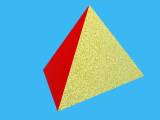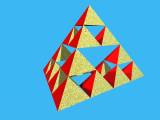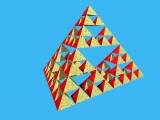Voir : la version texte avec indentation
Tétraèdre de Sierpinski
Tracé des différents itérés
La vision en relief permet de bien mieux appréhender ces surfaces complexes dans l'espace.
Ainsi, pour visualiser ces surfaces en relief ( images stéréoscopiques ), aller à cette page.
// Tétraèdre de Sierpinski
#include "colors.inc"
#include "sable.inc"
light_source { <6,10,-8> color rgb <0.95,0.95,1>*1.2 }
light_source { <-10,6,6> color rgb <1,0,1>*0.6 }
light_source { <-10,4,20> color rgb <1,0,1>*0.6 }
background { SkyBlue*1.2 }
camera { location <2,1.5,-7>
look_at <2.2,0.45,1>
}
#macro vmilieu(a,b)
<(a.x+b.x)/2, (a.y+b.y)/2, (a.z+b.z)/2 >
#end
#macro tetraedre (a,b,c,d)
union {
triangle { a,b,c}
triangle { a,b,d}
triangle { d,b,c}
triangle { a,d,c}
}
#end
/*
// variante de tétraedre (supprimer le pigment dans l'object final
#macro tetraedre (a,b,c,d)
union {
triangle { a,b,c pigment { Red*1.7 }}
triangle { a,b,d pigment { Green }}
triangle { d,b,c texture { sable2 }}
triangle { a,d,c pigment {White } }
}
#end
*/
#macro sierpinski(a,b,c,d,n)
#if (n=0) tetraedre(a,b,c,d)
#else
sierpinski(a,vmilieu(a,b),vmilieu(a,c),vmilieu(a,d),n-1)
sierpinski(vmilieu(a,b),b,vmilieu(b,c),vmilieu(b,d),n-1)
sierpinski(vmilieu(a,c),c,vmilieu(c,b),vmilieu(c,d),n-1)
sierpinski(vmilieu(a,d),vmilieu(d,b),vmilieu(d,c),d,n-1)
#end
#end
// n est le nombre d'itérations
#declare n=2;
union{ sierpinski (<0,0,0>,<4,0,0>,<2,3.464,0>,<2,1.155,3>,n)
pigment {
gradient <0,1,-0.38>
color_map {
[ 0.1 color red 1.0 green 1.0 blue 1]
[ 0.2 color red 1.0 green 1.0 blue 0]
[ 0.3 color red 1 green 0.8 blue 0.]
[ 0.5 color red 0.8 green 0.6 blue 0 filter 0.5]
} // color_map
scale 0.2/n}
finish {ambient 0.55 diffuse 0.7 specular 0.6 reflection 0.1 roughness 0.01}
rotate <0,75,-20>
scale <1.5,1,1>
}
 Début
Début












 Début
Début